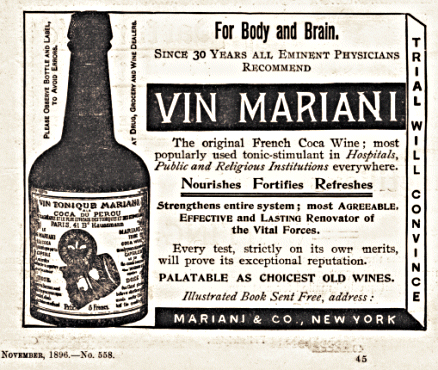 Vin
Mariani (or Mariani Wine) is thought to have been the first, debuting in France around 1863. It was a Bordeaux
wine in which coca leaves had been soaked.
Vin
Mariani (or Mariani Wine) is thought to have been the first, debuting in France around 1863. It was a Bordeaux
wine in which coca leaves had been soaked.
Thursday, January 5, 2006
Page 11
REMINISCING (Column)
Before There Was Coca-Cola, There Were Other ‘Cocas’
By ROGER M. GRACE
An Atlanta, Ga. pharmacist, John S. Pemberton (1831-88), is credited with inventing Coca-Cola. But even before his cocaine-spiked concoction was served at the soda fountain in his drug store starting in 1886, other beverages with the extract of the coca plant were being marketed.
 Vin
Mariani (or Mariani Wine) is thought to have been the first, debuting in France around 1863. It was a Bordeaux
wine in which coca leaves had been soaked.
Vin
Mariani (or Mariani Wine) is thought to have been the first, debuting in France around 1863. It was a Bordeaux
wine in which coca leaves had been soaked.
French writer Emile Zola called it “[t]he Elixir of Life, which combats human debility, the real cause of every ill—a veritable scientific fountain of youth, which in giving vigor, health and energy would create an entirely new and superior race.”
By the time Angelo Mariani began exporting his product to the United States in 1891, there were already cocaine-based tonics on the market here. To compete with them, he had to boost the cocaine content from 6 mgs. to 7.2 mgs. per fluid ounce.
Liebig Co.’s Coca Beef Tonic was among the products already available in the U.S. A Dec. 30, 1880 ad in the Fitchburg (Mass.) Sentinel declared that the tonic “embodies the nutritive elements of the fibre, blood, bone and brain of carefully selected healthy buttocks, combined with the powerful tonic virtues of the Coca, or Sacred Life Plant of the Incas, and a choice quality of Sherry Wine.”
An Aug. 10, 1881 ad in the Davenport (Iowa) Daily Gazette said the elixir was “prescribed by the most eminent physicians for weak lungs, falling out of the hair, (applied to the scalp,) weak and irritable throats, asthma, shortness of breath, chronic coughs, and all nervous afflictions.”
A Liebig ad appearing in the Feb. 3, 1885 issue of the Olean (New York) Democrat quoted retired U.S. Navy Lt. Lardner Gibbon (identified as “Commodore Gibbon”), an explorer of the Amazon in the early 1850s, as saying:
“The Coca has properties so marvelous that it enables the Indians, without any other nourishment, to perform forced marches for five and six days. It is so bracing and tonic that by chewing it alone they perform journeys of 300 miles on foot without appearing in the least fatigued.”
The tonic was produced in New York, Paris and London.
A “Dr. Scott” in Kansas City had a competing coca and beef tonic, to which he added iron and phosphorus. Druggist H.A. Estabrook of Fitchburg, New York, sold Coca Wine Bitters featuring a “Compound of Coca Leaves” and including other ingredients nowadays found at health stores: “Dandelion, Burdock, Goldseal, Mandrake, etc.”
A Hartford, Conn. firm manufactured Wyomoke Tea, a “coca leaf compound.” According to a Nov. 27, 1880 ad in Augusta, Maine’s Daily Kennebec Journal, “[i]ts equal is not known in dissipating the habits of Opium Eating, Strong Drink or Tobacco Chewing.”
It was billed as a cure for various ills, including neuralgia and “nervous headache.”
The health threat from chewing tobacco would be viewed today as trifling compared with the perils of ingesting cocaine, now known to be highly addictive and to cause severe psychological and physiological harms. But the extent of the dangers of cocaine was then unsuspected. The substance caused a noticeable uplift—rendering it a seemingly ideal ingredient for a tonic, and later soft drinks.
Another tonic containing cocaine was French Wine Coca. That was Pemberton’s brew. A June 8, 1884 ad in the Atlantic Constitution described the product in these words: “A superlative tonic and invigorator; a health restoring, strength giving, life sustaining prescription.”
The ad claimed:
“It improves the appetite, aids digestion, promotes nutrition, regulates the liver and bowels. A boon to all afflicted with nervousness, hysteria, neuralgia, melancholy, etc….”
In an 1885 interview with the Atlanta Journal, Pemberton said the drink was “composed of an extract from the leaf of Peruvian Coca, the purest wine, and the Kola nut.” He admitted it was patterned after Vin Mariani.
Just when Pemberton started experimenting with coca wine isn’t known, though it is known that his efforts to market the alcoholic preparation were stymied when Atlanta went dry. On Oct. 19, 1886, it became an absolute Prohibitionist city; an ordinance to let local residents consume beer was vetoed by the mayor the night before and the last of the places where liquor could be sold in the city was closed that day.
Pemberton set about to convert his “French Wine Coca” into a temperance beverage. Removing the wine, and adding sugar and citrus acid, he did just that.
Stirring the syrup into charged, rather than still, water, created a fizzy, tasty beverage resembling the Coca-Cola of today…except that today’s Coke does not have cocaine in it.
Copyright 2006, Metropolitan News Company